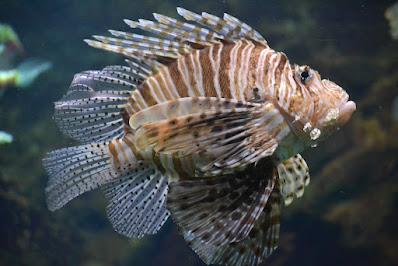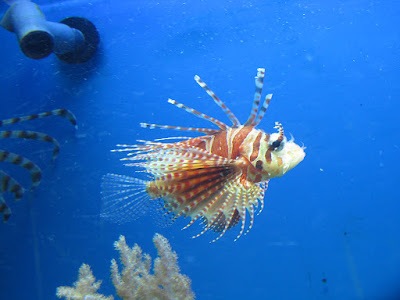Zebra turkeyfish - Zebra lionfish is an unusual looking fish with vertical stripes in orange, white and black on the body, and large, banded...
Zebra turkeyfish, also called as Zebra lionfish and its scientific name Dendrochirus zebra, will be a talking point in any aquarium. Their bright stripes serve as a warning to other fish to stay away and also confuse predators, as it allows them to blend into the reef. For added protection, juveniles have a large spot on either side of the body, which confuses potential predators into thinking that they are looking at the eyes of a much larger creature.
ZEBRA TURKEYFISH - DENDROCHIRUS ZEBRA DESCRIPTION:
Zebra turkeyfishis a marine, reef-associated species, normally found on coral or other rocky substrates of reef flats, in addition to being encountered in lagoons and caves in small groups in the Indo-West Pacific, including the Red Sea. This species has a maximum standard length of 25 cm, however, most often it is less than 20 cm.
It is an unusual looking fish with vertical stripes in orange, white and black on the body, and large, banded fan-like pectoral fins that flare out on either side as the fish lies on the seabed. The front dorsal fin is made up of thirteen tall, quill-like spines and the second dorsal fin has ten to eleven soft rays. The anal fin has three spines and about ten soft rays. The second dorsal fin, the anal fin and the rounded caudal fin are transversely banded in black and white.
It is a solitary predator in which individuals hunt exclusively by themselves and feeds mainly in the darkness. While originally described as solitary predators, they have more recently been observed exhibiting gregarious behavior both in the wild and in a laboratory setting, living and hunting together in groups of two or three.
The food is composed of crabs, shrimps, and juvenile fish. Venomous rays on the dorsal, anal, and pelvic fins serve as a defense against predators, while they also play an active role in male-male competition for females.
Zebra lionfish spawn in pairs. Courtship and spawning occur at night. The males are aggressive, while the females are smaller and develop almost white face when in courtship. Spawning occurs at the apex of a short and rapid paired ascent resulting in a gelatinous mass of 2000 to 15000 eggs. Hatching occurs 36 hours later and larvae settle out in a few weeks at a size of 10-12 mm.
ZEBRA TURKEYFISH - DENDROCHIRUS ZEBRA CARE:
Zebra turkeyfish are easy to care for as long as water parameters, a good feeding regime and correct handling procedures are maintained. They need the water temperature of 24-26 °C, pH of 8.0-8.4 specific gravity of 1.020-1.024. They are carnivorous, so feed meaty foods, live shrimp or small feeder fish.
Zebra lionfish has a very large mouth, which it uses to eat fish that can be nearly as big as itself. Ensure that any other fish in the aquarium are not small enough to be eaten, particularly cardinals, damsels, clownfish and gobies! However, it is peaceful to any fish that it can’t swallow such as large angels, rabbitfish, boxfish and eels. Males are very territorial and will attack a smaller male Lionfish, so only one male per tank.
Provide plenty of hiding places for this venomous fish. They like to take a rest from strong light, so ensure that they have some rock or a piece of coral under which they can hide. They are slow-moving and peaceful, but can be dangerous.
Their tank needs to be serviced with great care, because it is easy to catch a hand on one of their stinging spines. Transferring fish between tanks also needs to be carried out with caution. Never be tempted to use your hand to free a fish that becomes enmeshed in the material of the net, since this can result in a painful sting. Make sure you use a net that is large enough to accommodate the entire fish, and then, having caught it, invert the net carefully to let the fish swim out on its own. It will soon free itself, even if it is initially caught up in the netting.
Like other marine ornamental fish caught in the wild and kept in captivity, Dendrochirus zebra can develop health problems related to several factors encountered along the “chain of custody”, from capture to aquaria. For this reason, its introduction in the confined environment of the aquarium always has to be always carried out with careful acclimation and ensuring a readily available proper diet and suitable environmental parameters.
BUY ZEBRA TURKEYFISH AND RELATED PRODUCTS:














COMMENTS